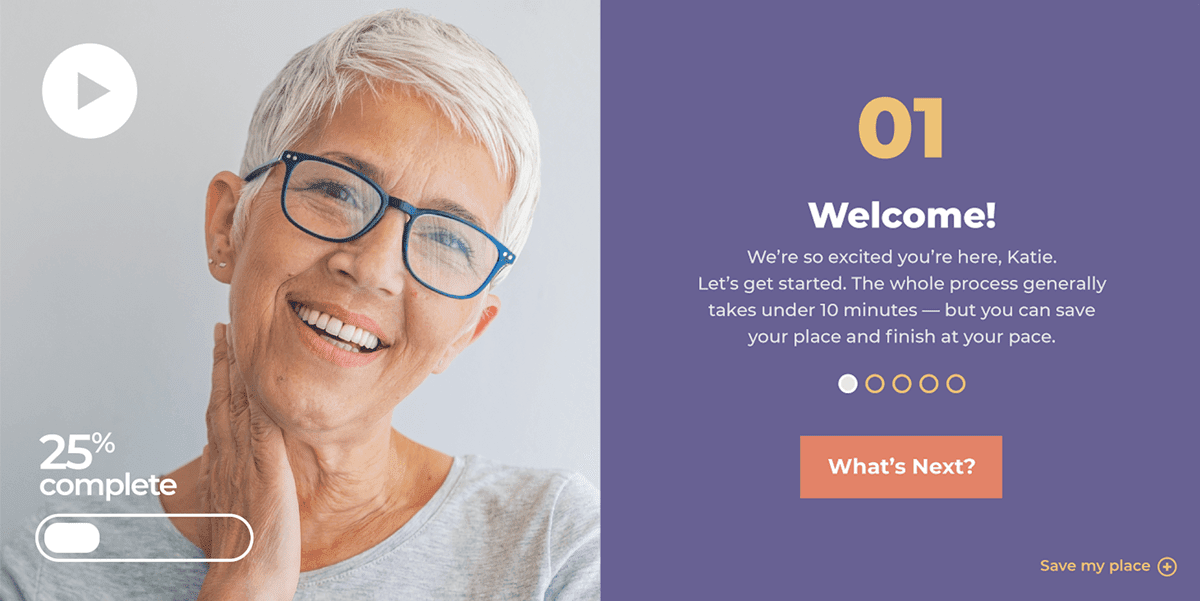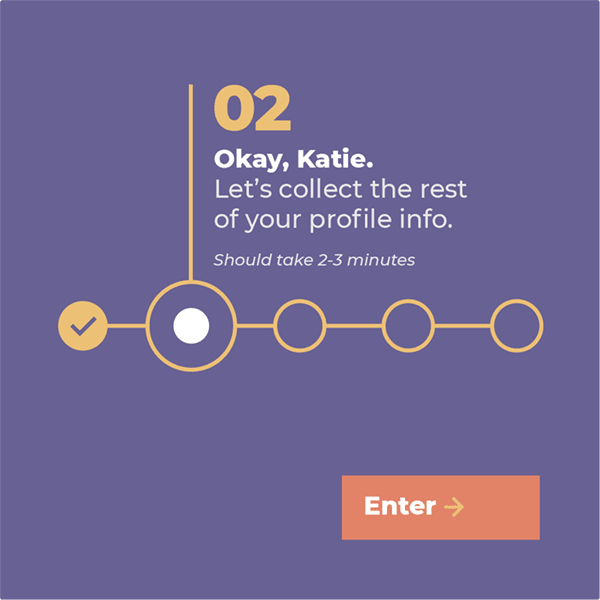To create a website that your customers actually enjoy using, you need to spend some time thinking about your users and figuring out how, when, and why they use your site.
In this article, you’ll learn how to use customer journey mapping to make a plan and get 10 key planning strategies to consider before you begin your website redesign project.
What is customer journey mapping?
Customer journey mapping is the process of visually showing what customers experience during different engagements with your business website.
You might create a customer journey map for anything from what happens when customers first sign up to use your service or buy a product for the first time to what happens when they are already a customer and come to your website for help.
Self-guided websites—developed with a foundation rooted in customer journey mapping—streamline the process of guiding users through a series of steps. They break down complicated steps by sharing information in digestible pieces. Often, they are unique and powerful enough they warrant their own theme or branding.
Here are some other examples of themed or branded journeys:
- Information gathering journey. Potential new patient visits a healthcare website to look at a doctor’s profile webpage to read her bio and see reviews before requesting an appointment
- Onboarding journey. Recently hired employee visits his new employer’s careers page to get a better sense of company culture
- Outreach journey. A foundation’s corporate donor looks at a nonprofit’s online annual report to see the organization’s latest successes
- Welcome journey. A new affiliate visits a company’s website after a new partnership is established
- Educational journey. Parents check out their church’s power or pillar page about how to lead their children to Christ and what to expect when their kids approach different milestones in their faith journeys
- Preference center journey. An existing customer visits their favorite publication’s email subscription page to self-select topics, delivery cadence, and media options

Brand engagement and customer journey mapping—why do they matter?
If designed properly, a self-guided customer journey website can drive more focused and immersive engagement with your brand. It can also help monetize services and offerings, explain or introduce products, activate constituencies, educate patients, intake employee data, and drive donations. In short, basing your strategy on customer journey mapping provides concentrated and enhanced value to your website visitors.
And, when that happens, you elevate the perception and value of your brand—all while providing meaningful moments for that person along the way, from welcome and contextual calls-to-actions and conversion possibilities.
“The last best experience anyone has anywhere, becomes the minimum expectation for the experience they want everywhere.”—Paul Papas, global interactive experience leader, IBM
An engaging journey adds many benefits to your marketing and brand engagement efforts. Here are some ways that customer journey mapping provides ROI:
To your marketing team:
- More thoughtful measurability for getting data-driven insights. Where did users linger, dig in, watch, download? What does this tell you about typical users’ needs and behaviors that you can use to enhance the customer journey elsewhere in your other communications?
- Greater website traffic. A site that meets users’ needs attracts the right kind of attention and will often lead to others backlinking to deeper information and assets on your website
To your users:
- Greater brand engagement. A welcoming website engages your users with your brand (and that makes your site stickier, an essential requirement if your goal is to keep users on your site longer)
- SEO “juice.” Figuring out what your users need then making sure you provide the answers they’re looking for—through the creation of helpful power or pillar pages—creates deep immersion
- More enjoyable presentation of functional requirements. Do you really need to require getting a secondary phone number before letting a new user sign-up for your monthly email newsletter? Probably not. When a website gathers only what it needs and nothing more, it makes the often tedious process of ponying up information to get what you need more palatable to users
Key planning strategies for customer journey mapping
Self-guided website models continue initial momentum with your audience, generate action, and answer the question of, “What happens next?” for an individual new to your organization. While initial engagement with your brand is still fresh on that person’s mind, moving directly into those next steps is critical.
So, what are those next steps?
1. Plan (measure twice, cut once)
Like selecting a movie, we lose interest quickly if the content doesn’t turn out to be enjoyable, meaningful, or engaging. Creating a journey experience is no different. To create a journey that is a pleasure to navigate, easy to understand, and appealing—even story-driven—upfront outlining, planning, and mapping are key.
2. Journey orchestration and decisioning
Mapping out journey milestones in advance often reveals key moments of opportunity to capture valuable data and insights. As the user makes their way through the steps set before them it may be helpful to ask them to occasionally “raise their hand” and self-identify.
For example, if presented with two options for hip pain relief services, a user’s selection can trigger more relevant and in-context content. But, their selection also helps you segment those individuals into discreet audiences and better understand their unique preferences.
3. Gather or create compelling content
After you’ve mapped your journey, inventory your current on-hand assets. Then create a list of gaps in the content you know the visitor should encounter along their journey, offers, and incentives included.
4. Incentivize (create artifacts worth collecting)
Encapsulated journeys can provide a warm and welcoming way to alleviate the tedium of necessary information gathering, dissemination, and processing.
Consider rewards and recognition you can provide—even surprises—in exchange for progress made. Organize and orchestrate these incentives to keep your audience walking away with a great feeling about your brand. These offers might include:
- Generating a PDF that outlines a user’s completed tasks so they can download and store it for safe-keeping and easy off-line referencing
- Building in functionality that allows a user to save their progress as they go so they can return and complete from where they left off
- Giving a user recognition for completion (e.g., coupon for a discount on merchandise, complimentary ticket to an upcoming event, access to exclusive content, or a limited-time introductory subscription to a service like Disney+, Apple One, or LifeLock) and including short messages, like an affirming “almost there” to recognize their progress and make them feel good
When it comes to customer journey mapping and brand engagement always consider, “What’s in it for them?”
Pro-tip: Leverage third-party industry data, customer data, and marketing or website persona profiles to help ensure you truly connect with your audience—in their language.
5. Brand engagement (Pay attention to the user interface layer)
Creating a self-guided journey designed to engage site visitors for extended periods of time places a premium on user-centric design—from journey mapping and user experience to brand essence, human-centric, and responsive thinking.
Consider, for example:
- Which journey elements will translate for users visiting your website from mobile devices? Which won’t?
- Is the journey compelling and interesting enough to stick with, navigate, read, look at, and learn from?
- Where is the best place to insert calls-to-actions? (Don’t mislead or oversell! Instead, present information in natural context with your content, always keeping the individual’s interest in mind first and foremost.)
- Which assets, links, way-finding elements, artifacts, offers, services, and information should you include? When? Where? What’s in it for your audience?
- A self-guided construct is an opportunity for a unique user experience, but how will it connect to your core brand? Or, if it should not—why?
Customer journey mapping can take many forms. But whether your journey is an ungated pillar page featuring concentrated topical content, an onboarding journey, a friendly welcome center, or a custom-tailored preference center, excellence in visitor engagement and interface design is always a top-level aim.
6. Expose other services or products along the journey
Self-guided website designs create a perfect platform to expose and educate audiences about your extended products and services in a contextual way. Your customer journey can even function as a dynamic FAQ, reducing cost and lessening the burden on frontline staff in answering common, recurring, or redundant questions, e.g., answer them along the audience website journey instead.
Journeys also present extended messaging possibilities. For instance, If a visitor saves their progress mid-journey and exits, send a timed email encouraging them to return and finish—including a brief, “Did you know?” benefit blurb about a relevant product or service.
7. Keep in content management system constraints
Encapsulated journeys often require a unique design or construct. Your current website templates may, or may not, allow for an elegant step-through experience. Always meet early on with your developer to explore design options, whether that’s a themed and branded micro-site, new templates, or other ideas.
According to Pointillist’s 2020 State of Customer Journey Management and CX Measurement, 95% of high-performing organizations have adopted a journey-based approach to consumer or customer experience and 80% of respondents reported that a journey-based strategy is critical to the overall success of their business.
8. Consider compliance
As with any site, from HIPAA compliance to ADA & WCAG standards, take the time to ensure you are not overstepping in your information gathering nor presenting content in a manner that some patients, constituents, donors, or customers can’t interact with.
For some highly regulated organizations such as healthcare, financial, or nonprofit concerns, ignoring ADA standards could adversely influence funding or even leave you open to unnecessary legal scrutiny.
9. Create an up-front contract with the visitor
Rolling up even complex journeys into three to five overarching journey milestones helps create a sense of, “I can do this,” in the visitor’s mind. And like any worthwhile journey, creating a sense of anticipation can be a powerful tool in enticing a visitor to advance and stick with the process.
Introducing simple progress indicators to mark those milestones from the outset of a journey helps calm anxiety and establish a shared expectation around the depth of commitment for your audience.
Showing an estimated amount of time to complete a section, the number of sections left to complete, or the ability to save progress and return later, all point to your brand putting your visitor first.
10. Remember: It’s a journey, not a chore
Consider creating a conversational feel to your content and serve it up using language and a voice that resonates with your audience. Or go one step further to Integrate story vignettes along the way, leveraging the power of passively ingested media like podcast segments, short videos, or content revealed on rollover.
Customer journey mapping can increase brand awareness, elevate engagement, and improve a website’s user experience, all while helping advance conversion. Make sure it’s a part of your next website planning session.

